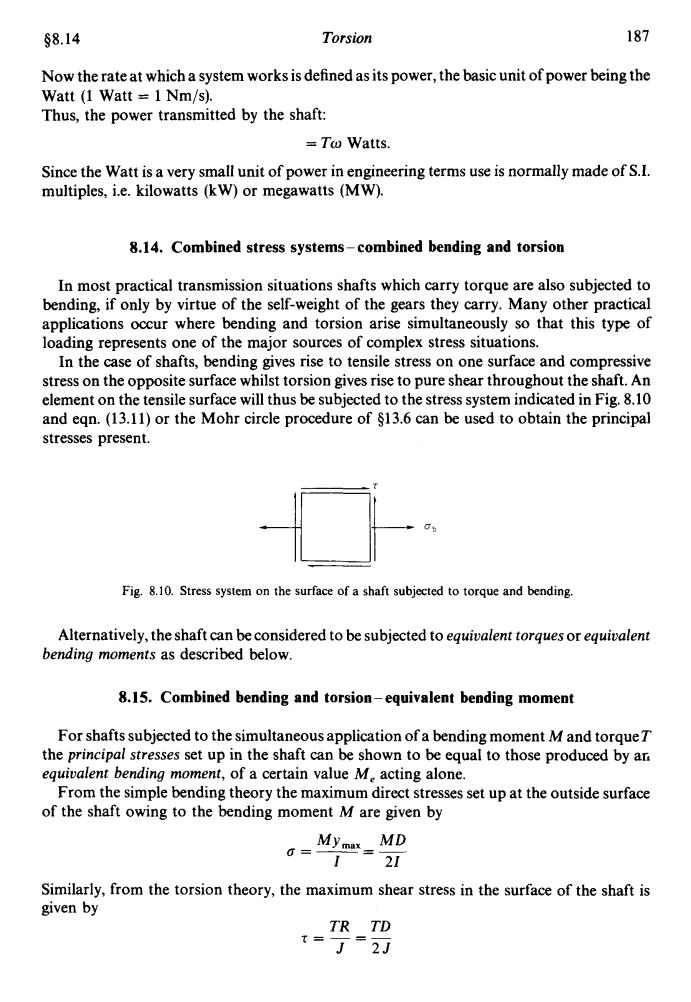正在加载图片...

$8.14 Torsion 187 Now the rate at which a system works is defined as its power,the basic unit of power being the Watt (1 Watt =1 Nm/s). Thus,the power transmitted by the shaft: To Watts. Since the Watt is a very small unit of power in engineering terms use is normally made of S.I. multiples,i.e.kilowatts (kW)or megawatts (MW). 8.14.Combined stress systems-combined bending and torsion In most practical transmission situations shafts which carry torque are also subjected to bending,if only by virtue of the self-weight of the gears they carry.Many other practical applications occur where bending and torsion arise simultaneously so that this type of loading represents one of the major sources of complex stress situations. In the case of shafts,bending gives rise to tensile stress on one surface and compressive stress on the opposite surface whilst torsion gives rise to pure shear throughout the shaft.An element on the tensile surface will thus be subjected to the stress system indicated in Fig.8.10 and eqn.(13.11)or the Mohr circle procedure of $13.6 can be used to obtain the principal stresses present. Fig.8.10.Stress system on the surface of a shaft subjected to torque and bending. Alternatively,the shaft can be considered to be subjected to equivalent torques or equivalent bending moments as described below. 8.15.Combined bending and torsion-equivalent bending moment For shafts subjected to the simultaneous application of a bending moment M and torqueT the principal stresses set up in the shaft can be shown to be equal to those produced by an equivalent bending moment,of a certain value M.acting alone. From the simple bending theory the maximum direct stresses set up at the outside surface of the shaft owing to the bending moment M are given by Myn_MD 0= 2I Similarly,from the torsion theory,the maximum shear stress in the surface of the shaft is given by TR TD t==268.14 Torsion 187 Now the rate at which a system works is defined as its power, the basic unit of power being the Watt (1 Watt = 1 Nm/s). Thus, the power transmitted by the shaft: = To Watts. Since the Watt is a very small unit of power in engineering terms use is normally made of SI. multiples, i.e. kilowatts (kW) or megawatts (MW). 8.14. Combined stress systems - combined bending and torsion In most practical transmission situations shafts which carry torque are also subjected to bending, if only by virtue of the self-weight of the gears they carry. Many other practical applications occur where bending and torsion arise simultaneously so that this type of loading represents one of the major sources of complex stress situations. In the case of shafts, bending gives rise to tensile stress on one surface and compressive stress on the opposite surface whilst torsion gives rise to pure shear throughout the shaft. An element on the tensile surface will thus be subjected to the stress system indicated in Fig. 8.10 and eqn. (13.11) or the Mohr circle procedure of 513.6 can be used to obtain the principal stresses present. Fig. 8.10. Stress system on the surface of a shaft subjected to torque and bending. Alternatively, the shaft can be considered to be subjected to equivalent torques or equivalent bending moments as described below. 8.15. Combined bending and torsion - equivalent bending moment For shafts subjected to the simultaneous application of a bending moment M and torqueT the principal stresses set up in the shaft can be shown to be equal to those produced by afi equivalent bending moment, of a certain value Me acting alone. From the simple bending theory the maximum direct stresses set up at the outside surface of the shaft owing to the bending moment M are given by Similarly, from the torsion theory, the maximum shear stress in the surface of the shaft is given by TR TD J 25 7=-=-